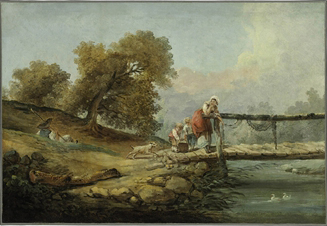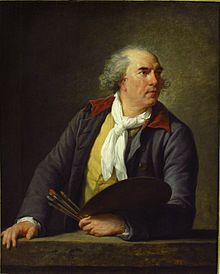 home
about
artists
exhibitions press
contact
purchase
home
about
artists
exhibitions press
contact
purchase |
|||
|
HUBERT ROBERT (1733 – 1808)
'French Landscape' or 'La Passerette', oil on canvas, 43 x 63 cm
Hubert Robert (22 May 1733 – 15 April 1808), was a French painter, noted for his landscape paintings and picturesque depictions of ruins. Hubert Robert was born in Paris in 1733. His father, Nicolas Robert, was in the service of François-Joseph de Choiseul, marquis de Stainville a leading diplomat from Lorraine. Young Robert finished his studies with the Jesuits at the Collège de Navarre in 1751 and entered the atelier of the sculptor Michel-Ange Slodtz who taught him design and perspective but encouraged him to turn to painting. In 1754 he left for Rome in the train of Étienne-François de Choiseul, son of his father's employer, who had been named French ambassador and would become a Secretary of State for Foreign Affairs to Louis XV in 1758. He spent fully eleven years in Rome, a remarkable length of time; after the young artist's official residence at the French Academy in Rome ran out, he supported himself by works he produced for visiting connoisseurs like the abbé de Saint-Non, who took Robert to Naples in April 1760 to visit the ruins of Pompeii. The marquis de Marigny, director of the Bâtiments du Roi kept abreast of his development in correspondence with Natoire, director of the French Academy, who urged the pensionnaires to sketch out-of-doors, from nature: Robert needed no urging; drawings from his sketchbooks document his travels: Villa d'Este, Caprarola. His success on his return to Paris in 1765 was rapid: the following year he was received by the Académie royale de peinture et de sculpture, with a Roman capriccio, The Port of Rome, ornamented with different Monuments of Architecture, Ancient and Modern. Robert's first exhibition at the Salon of 1767 was greeted in print by Denis Diderot, "The ideas which the ruins awake in me are grand." He was successively appointed "Designer of the King's Gardens", Keeper of the King's Pictures" and "Keeper of the Museum and Councillor to the Academy". Robert was arrested in October 1793, during the French Revolution. He survived his detentions at Sainte-Pélagie and Saint-Lazare by painting vignettes of prison life on plates before he was freed at the fall of Robespierre. Robert narrowly escaped the guillotine when through error another prisoner died in his place. Robert died of a stroke on 15 April 1808. From Wikipedia |
|||
|
|
E-mail: info@hayhillgallery.com |
||

